|
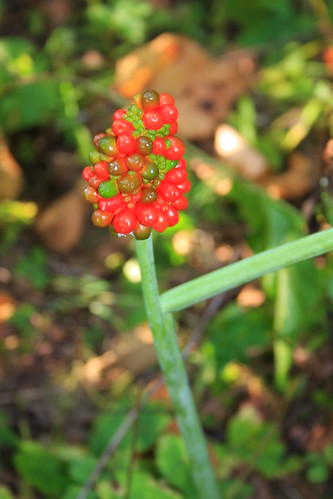
Green Dragon, Arisaema dracontium.
(*photo credit)October 1, 2011
Twenty Suggestions for a Busy October
We
ought to busy ourselves in preparation for the upcoming harsher weather and
consider this what-to-do list:
*
Pick final frost-sensitive garden tomatoes, beans, and peppers and prepare to
insulate the more sensitive vegetables so they are not killed by frost and wind
(presuming late frost areas);
*
Enjoy the fresh autumn greens: endive, arugula, kale, mustard, spinach, lettuce
of different varieties, Swiss chard, parsley, and collards;
*
Put on the plastic covers to winterize certain vegetables for late autumn and
winter harvesting;
* Harvest or purchase
pumpkins and squash for decorations and pies;
*
Camp out amid the fullness of the colored trees, and take along either bedding
and clothes to endure the chill;
* Finish stacking firewood
for the winter heating stove and ensure that others do the same;
* Fill the bird feeders for
the departing aviary friends heading south, and to fatten the ones staying
through harsh months to delight us through the winter days;
*
Take an autumn walk through the woods or country roads with someone who admires
the landscape;
* Observe the scampering
squirrels and let them have the walnuts and hickorynuts if they insist, for that
is their winter store;
* Make sure the auto and
other motor vehicles and implements are winterized, and the summer lawn and
garden equipment have been drained and properly stored away until 2012;
*
Attend a special autumn festival or church event where all celebrate the season
fully;
*
Put covers and plastic sheeting on the uninsulated windows and glass panels on
doors, and add any caulking that may prove necessary to close out air leaks;
* Stay aware of the weather
and the drops in temperature so that you have time to photograph that first
frost of the season and the last flowers in the garden;
*
Decide on the winter reading period and make plans to pack and carry along books
and magazines in case of a sudden snow event that will maroon you somewhere;
*
Compose an autumn poem of a story that occurred during the summer that is well
worth remembering;
*
Harvest the elderberries for a pie, a cobbler or some other baked treat;
*
With cooler weather thank God for surviving the heat of summer and the
plentitude of the autumn harvest;
*
Get out winter clothes and the snow shovel and the materials to use on walkways
and roadways; and
* Observe the sounds and
smells of the month.
Prayer:
Thank you, Lord, for the coolness of autumn; in a spirit of gratitude help us
plunge into the season ahead.

Grasses, swaying in autumn breeze.
(*photo credit)October 2, 2011
Restore the Forsaken Vineyard
There was a property owner who planted a
vineyard. (Matthew 21: 33-43)
It's harvest time.
Vineyards are familiar sites in the Holy Land, for grapes are the national
symbol, and the vineyard is a favorite and cherished place. To mistreat a
vineyard is like cutting a tree -- a sin against the land and people. In St.
Matthew's gospel, this parable with its setting is an allegory (a teaching
method for moral principles where things and people have a hidden symbolic
meaning). The vineyard is cared for by the owner, but the tenants refuse to
share the produce with those sent, and even mistreat the slaves. This allegory
identifies Israel, the vineyard of the Lord is the house of Israel (Psalm
80), as that which bears wild grapes. The wicked tenants reject the son of the
King who is sent. Rejecting the will of God is wrong, and so we learn lessons
that apply to all of us who do misdeeds as well.
A few years back, the Public
Broadcasting System had a two-and-a-half hour show on Pope John Paul II, and
though it passed over some important parts of his long life, it did focus on
certain themes, one of which is the Jews and how John Paul II strived to
eradicate anti-semitism from the Church in his example and writings. It said
now through that Pope's efforts the Polish people confess sins of anti-semitism.
Both the story of Israel and this persistent anti-semitism may seem remote to
many of us, but they invite deeper reflection. If the parable were on road rage
and how some drivers curse or even punch out the fellow in front of them in a
traffic snarl, it might be closer to home. But isn't the parable itself right
at home, and the problem of mistreating God's gifts (our Earth) the same as that
of the wicked tenants?
Look more deeply. God has
patiently prepared this priceless planet from times of old (billions of years,
in fact), and Earth has evolved in the glory of its uniqueness in this vast
universe. We are tenants for, in our short span of mortal life, we are
privileged to live on this planet containing a delicate balance of fresh air,
potable water, and fertile soil. But we have messed this Earth up, littering
it, subjecting its messengers of plants and animals to inhospitable
environments, and threatening, endangering and even killing them. Through
actions causing environmental pollution, we have threatened Earth herself.
In part, we are the current
problem, and that makes it all the more disturbing. However, we must not lose
heart; we must listen to the Spirit prompting us to curb our selfish ways,
conserve resources, and share our many gifts with those in need. We may be part
of the problem but, as brothers and sisters of Jesus, we can also contribute to
the solution. We have the awesome power to give our Earth new life, if we work
together and do not lose heart.
Prayer:
Lord, teach us to discover that our gifts are fragile and in need of constant
protection and healing.
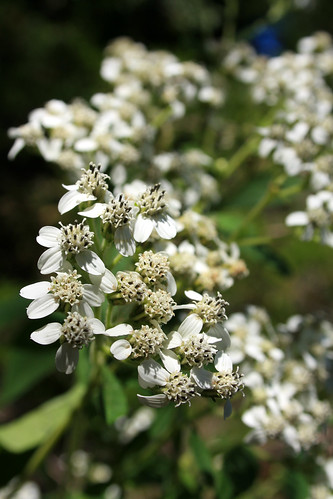
White crownbeard, Verbesina virginica.
(*photo credit)October 3, 2011
Acknowledging Social Addictions
People who observe
addictive behavior and seek to relate to addicts who suffer from a host of
personal addictions (alcohol, drugs, etc.) focus on individual behavior, efforts
at control, and available means of healing these addicts. The prime attention
is to address the individual's dysfunctionality and improve the addict's health,
social relationships, work activities, and other responsibilities. Here
addiction is a personal plight, and the importance of such attention and
treatment is not discounted.
Social
behavior mirrors individual conduct; so does social misbehavior. Social
addiction is increasingly emerging whether specific practices or materials are
truly addictive (a decade ago, President Bush stated that Americans are
"addicted to oil"). The economic and political system that we call our modern
world in the West and emerging nations is mesmerized by material consumption,
and experts tell us that 70% of the entire world economy is based on increased
consumer spending. Autos, spacious homes, cell phones, electronic devices, and
resource intensive (animal product) foods point to a culture overly focused on
material acquisition, retention, and consumption. The captains of industry and
commerce seeking to satisfy this "wanted" (not needed) consumption have accrued
a growing disparity of wealth never before amassed; all the while, millions
aspire to enter this materialistic culture.
The compulsion to buy, mall,
and use more and more consumer products that never satisfy lead to competitive
demands on scarce resources; this results in our environmental crisis with its
unsustainable and Earth-damaging quest to extract, use, pollute, and dispose of
wastes. The unchallenged practice is addictive, with all the parallels of
personal material addictions. Cultures reinforce this practice through peer
pressure and advertisement and pervasive commercialism. At this point the three
major sins of omission emerge as social temptations. Denial is a refusal
to acknowledge personal sin and that such consumption leads to global harm,
climate change, and threats to the very life of this planet. If the threats are
perceived, the human tendency of consumers is to excuse themselves and
shift responsibility to enlightened or powerful leaders or experts. The problem
is magnified by many who recognize harmful social dimensions and the inadequacy
of policy makers to confront it. To keep from being overwhelmed, nervous
observers escape to other sub-addictions.
When
the social addiction is perceived and some action seems necessary, the road is
not yet clear. First, we may modify behavior such as to limit consumer intake
so the addiction is not debilitating; second, addicts could surrender to a
Higher Power and work with others for joint addiction controls as seen in the
forthcoming reflection.
Prayer:
Lord, give us deeper spiritual insight to see the problems that face our planet,
to convince others of the need for reform, and to view our failures
as culprits and silent observers.
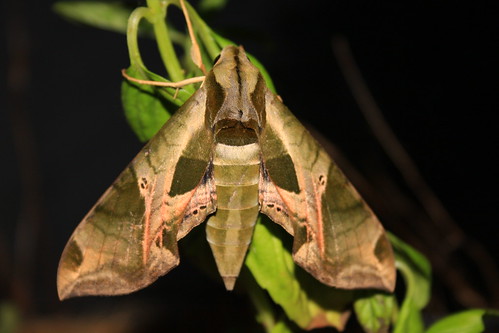
Efficient camouflage, Pandorus Sphinx Moth (Eumorpha pandorus).
(*photo credit)October 4, 2011
Confronting Social Addictions
On
this feast day of Francis of Assisi, we find someone who confronted the
social addictions of his family and culture. He sought to confront these
conditions personally, and he found Christ as a companion on his mission to
bring compassion to all around him. Francis chose to do this through poverty
and simplicity of life. He confronted wrongs through a reinforcing group of
like-minded voluntary poor. Thus, the group's appetites were controlled and
they became models for the wider community. This voluntary attractiveness meant
a solidarity with the poor to a far deeper level than merely observing social
addictions and personally shunning or modifying them. Here, compassion or
suffering with others becomes a participation in the redemptive act itself.
We
are moved by voluntary associations that seek to become models for others, but
these must compete with a prevailing culture of consumption. A few people will
simplify, but will the great multitudes? Bob Sears, my colleague of many years
on ecological matters, agrees that movement to social addictive behavior
requires a close look for clues at levels of addictive controls and cures.
Alcoholic Anonymous (AA) moves addicts away from their attachments through
twelve steps that include convincing individuals of their weakened state,
exposing the need for support groups, and surrendering to the need for a Higher
Power with continued assistance in the control process. However, Bob points to
the experience of Chris Prentiss in the book AA's Twelve Steps that the
addict must go beyond controlling an addiction to curing one from a dependency
on drugs.
A
holistic recovery method is necessary, and that all energies must be directed to
healing. This opens the door to new and creative ways to address the addiction
problems at the individual level -- procedures that find good merit when addicts
find self-worth in converting dependencies to new creative energy levels.
At
the level of general consumer or social addiction, the problems are not so
easily solved. Earthhealing must consist of more than conservation
(control measures) of resources when the entire system is highly dysfunctional.
We cannot deny the addiction; we cannot excuse ourselves from taking
responsibility, and it is not proper to escape (an addictive process in
itself) by attachment to less polluting or resource-intensive material things.
The solution must be positive, must be effective, and must be spiritual in
nature. We need God's help to address the heart of the environmental crisis; we
must be willing to surrender ourselves to this Higher Power, and we need the
help of others who are sufferers with us. A willingness to suffer with them is
compassion, and one that does not resort to violence.
Prayer:
Lord, help us to see that a surrender to you and your power as saving Lord
touches the heart of the afflicted, because this solution must be
heart-to-heart, not by commands to be subservient but to be participative in
your grand design.

Field thistle, Cirsium discolor, native Kentucky wildflower.
(*photo credit)October 5, 2011 Healing
Social Addictions
The
third and incomplete focus in dealing with social addictions is to move from
acknowledgement (a creation-centered, rational approach) to confrontation of the
problem (a personal redemption-centered, voluntary approach) that allows a
certain amount of control, but not deep social healing. To heal demands ever
deeper penetration into addiction, and this is the demand for accompanying our
God in the act of salvation of our wounded Earth.
We cannot do earthhealing
alone. Something deeper is needed than acknowledgement of a problem HERE
before our planet, and voluntary means of control that are urgently expected in
this wounded Earth NOW, because of the damage to individuals and their
communities. We are inadequate at the individual or even local communal level
and must stretch out to a WE -- a social team approach that sees renewal
of all and not just the individual as goal. The problem is created and there is
misuse of the balances found in nature, but rational creation-centered
approaches only acknowledge problems and do not solve them. Individual
instigated actions as to redemption-centered approaches show urgency, but they
do not penetrate a global level in which we must identify ourselves with the
flora and fauna. We are invited to the deeper level of poverty that embraces
the human and other living creatures as well and to see ourselves as addicting
and addicted.
A
first level of humility is to acknowledge that people are crushed by
addiction, but in so doing we stand at a distance and yet want to enter into the
sufferings of others in some manner. At the second level of humility, we
enter into the control of the addiction through approaching solidarity to the
addicted party. At a third and deepest level of humility to which
the Spirit beckons us, we admit our part of the community of the addicted. We
take on the addiction as a surrender of the deepest variety. Here we are poor
with and among the poor -- and removed from those who regard their wants as part
of their privileges. Here "commons" takes on a spiritual dimension -- for
ultimate success depends on raising an impoverished world with God's grace. We
are responsible at least by implicit addictive behavior and, as democratic
people, by having allowed addictive conditions to arise and co-exist
uncontested.
The
poor will lead the way. A renewed or resurrected Earth resides in the
dreams of the poor who hunger for the basics of life. Because of the full
meaning and operative nature of this authentic dream, the poor embody a
potential empowerment to rise as a body and take what is rightfully
theirs/ours. This has to be more than mere forsaking of wealth (an act of power
by the affluent). Genuine healing is ideally performed when all give generously
and all take only what is necessary and share with all.
Prayer:
Lord, help us to go beyond simply knowing about addictions, and leading others
to control their impulses. Help us to accept the deeper reality of healing and
to enter the community of the impoverished in order to
carry out this process.
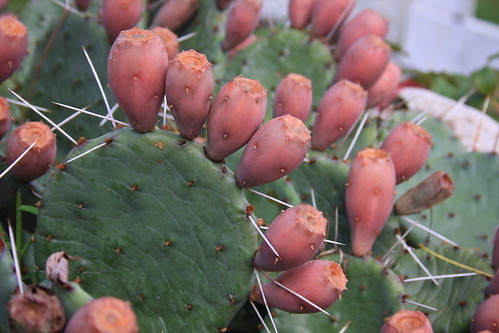
Kentucky's prickly pear cactus, Opuntia humifusa.
(*photo credit)October 6, 20111
Compassion and Social Addiction
The
challenge for global activists is to see the problem of addiction as both an
individual and a social matter. This social insight refutes the position of
libertarians who would most likely deflate any mention of a group having a
social consciousness. On the other hand, a social awareness of addiction
challenges neo-liberals, who are truly part of the system and are convinced that
mere tweaking of that dysfunctional system (see Reclaiming the Commons, Chapter
Three), will return ecological balance to the planet. Furthermore, those who
see the need for profound change include many who prefer violence -- and yet
this could trigger the privileged to a violent counteraction. Instead, we must
join non-violent global radical forces who seek lasting change.
Bob
Sears indicates that individual addiction is approached through progressive
levels ("Interrupted Love," Journal of Christian Healing, 26, #2.
Fall/Winter, 2010). The challenge is to take his insight and transpose it to
our shared social level. As our three previous reflections indicate, we
discover a social problem (materialistic affluence or its desire), an avoidance
(corrective measures through voluntary simplicity), and curative measures of
ever deeper levels (acceptance that we are part of the impoverished social
addiction). One may see these levels in a secular manner; however, with God's
grace, believers seek ever deeper relationships to God -- creator, savior, and
spirit. Christians acknowledge their weaknesses, surrender to divine mercy, and
show willingness to take Spirit-inspired participative action as healers in
God's family fashioning a New Heaven and New Earth.
Ecologically,
social addiction is so deep that mere voluntary practices (recycling,
insulating, eating nutritious foods) do not solve the problem; nor do technical
improvements (driving efficient vehicles, adapting renewable energy); nor do
forms of violent renewal (terrorism). We need resources, including financial
ones, now held by the powerful wealthy (Reclaiming the Commons, Chapter Eight)
in order to pay for shared resources; these involve essential materials for one
billion of the world's destitute.
Theologically,
a resurrection-centered spirituality is called for and is based on an
ever-deeper personal surrender to participation in the Divine Act of salvation.
Jesus is an activist; Mary is a co-activist. This sharing in non-violent
activism goes to the compassionate divine heart. We are willing to suffer with
others and become one in their weaknesses. This reaches beyond rational
insight, passive surrender, and violent revolution. Rather, this continues the
activism of Jesus in driving out moneychangers and challenging Pharisees; we
journey with Mary to her cousin Elizabeth, enter the Cana feast, and stand with
her at Calvary. Earthhealing becomes an involved process.
Prayer:
Lord, share with divine compassion shown by those close to you in union with
Earth's suffering people and other creatures.

Yellow crownbeard, Verbesina occidentalis, Mercer Co., KY.
(*photo credit)October 7, 2011
Campfires and Playing with Fire
Once
more Fire Prevention Week makes us pause to look beyond standard fire
prevention procedures and caveats found in previous October reflections. For
some of us who have camped in virtually every state and some provinces of
Canada, a campfire at various times and seasons seemed the most important
component of a good camping experience. The blaze, the crackle, the smell and
taste of wood smoke, and the warm feeling on cool nights makes this a
sense-filled aspect of being outdoors. However, drought and environmental
considerations make such favorite considerations a thing of the past. This
brings back memories of starting a camp fire in Oregon when the bone-dry tinder
just about exploded -- and we became so frightened that we immediately put the
fire out.
If
we look at campfires in their prime existence, these were the sites where early
human beings took charge of their environment, for here they controlled fire
(through flint or by carrying coals to a new combustible deposit site) for
warmth, cooking, driving away wildlife, and lighting. The campfire invited
togetherness and then the first of ageless litanies of campfire songs and poetic
expressions of the yearning hearts of people coming to know their powers. In
more recent times, making a campfire successfully was a mark of maturity, native
skill, and natural expertise, as well as a time of being appreciated by those
less versed in such practicality.
Looking
beyond the benefits of campfires, we see that in many places today due to
various climatic and ecological conditions, such fires are discouraged or even
forbidden. Often such fire sites are messy and disturb wildlife and landscape
alike; it takes precious resources when such fires use locally grown materials
in certain areas. We know that a few of the worst Western state fires this year
have been started as campfires that quickly got out-of-hand and eventually burnt
tens of thousands of acres of grassland and forested areas.
We
are in an age when playing with fire by grown-ups is considered as inappropriate
as allowing infants to play with matches. However, the Easter fire event on
Holy Saturday is when we put this entire affinity with fire into the Liturgy
itself and the resurrection mystery. We are all mesmerized by fire since the
first human conquest (control of the combustion process for betterment). Being
drawn thus is the nearest thing to a learned/instinctive reaction that we
possess as human beings. We are somehow wired to fire and yet we need to
control our wiring in an ever more mature manner. Campfires are often mature
people playing with fire, and we have to learn that refraining from this is both
a safety and an environmental issue. Alternatives may need to exist: simulated
lighting that looks like campfires even with color and odor. Has that been
invented and patented yet?
Prayer: Lord, give us
the grace to know how to use all your gifts well, even the gift so mundane as
fire itself.

Jewelweed, in bloom..
(* photo by Lindley Ashline, Creative Commons)October 8, 2011 Jewelweed
Benefits throughout the Year
Our
Daily Reflection on June 28, 2006 tells of the glories of the beautiful
jewelweed (some Americans call it "touch-me-not"), Impatiens capensis.
Is there more to be said? A problem I always had was that the sap was a
wonderful ointment for poison ivy or mosquito bites and scrapes of all sorts,
and yet during the off-season nothing of this sort seems available. Maybe there
are no mosquitoes after frost, but the poison ivy is still a nuisance.
Actually, one can preserve the soothing ingredients of jewelweed for the rest of
the year, if the material is prepared properly and kept refrigerated.
-----------------
Preparation
One cup of oil (olive, soy,
sunflower or canula oil).
Four
ounces of fresh jewelweed (can be leaves, flowers, stalks, or even roots)
chopped into small pieces or two ounces of dry
jewelweed.
Two capsules of 400 iu
Vitamin E oil.
One teaspoon of tea tree
oil.
One-and-a-half ounces of
melted beeswax (3 tablespoons) if
you desire a solid salve.
Add oil and jewelweed to a
small crock pot or double boiler.
Heat over low setting of
crock pot for four to five hours (double boiler
simmering water for three hours).
Strain out plant materials.
Squeeze Vitamin E capsules
into mixture.
Add beeswax and tea tree
oil.
Stir until cool and pour
into containers.
------------ Pat Novak, Irvine, KY
If
properly preserved the ingredients will not turn rancid for at least a year. Once
collecting the ingredients, a fresh batch can be composed annually. The good
part of doing so at the end of the growing season is that one can enjoy the
orange or yellow jewelweed flowers throughout the growing season and the
moisture content will decrease over time (the moisture is not an active
ingredient). At least dry the jewelweed until later in autumn (about two stalks
per ounce). A very low-priced ointment!
Prayer:
Lord, keep us aware of the little things of life.
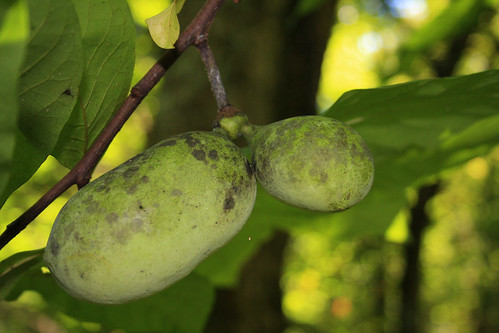
Ripening pawpaw (Asimina triloba), native Kentucky fruit.
(*photo credit)
October 9, 2011 Come to the
Banquet
The reign of God may be
likened to a king who gave a wedding banquet for his son.
(Matthew 22:
1-14)
As we prepare to celebrate
World Food Day next week, we ought to see that our Creator has given us a
banquet of food gifts -- if we only use them conservatively and share them with
people in need. Celebration in the form of sharing food and a meal is
found in virtually all cultures; it was observed in Israel and in the Canaanite
culture that preceded it. Pacific Islanders, Native Americans, and Africans
have celebrations and festive foods -- much as our American Thanksgiving meal is
a festive event. Guests and seating arrangements are often carefully planned.
Jesus was undoubtedly social and liked meals and feasts. He was at a wedding at
Cana for his first miracle, and he attended enough feasts that he was asked why
he did not fast from eating and drinking.
Jesus
used one such occasion as the background for his parable; he manifested his
social nature to include the perpetual memorial -- the Eucharistic meal. In
fact, the reign of the Kingdom of Heaven is like a meal -- full of life and joy,
including inviting and sharing. The multitude allows for social support as do
churches and chapels of all sizes, or vast gatherings such as at the recent
World Youth gathering in Spain. We celebrate our common past through
gatherings; we prepare for and expect a greater future when we all assemble and
share with each other.
God prepared this Earth
during billions of years for our arrival and presence. In only an instant of
geologic time, we human beings have entered the scene and left our marks on this
fragile Earth. We have not appreciated God's gifts, whereas we ought to have
constantly said, "thank you," a free act, which only human beings can utter.
Gratitude for gifts given is the pinnacle of created beings. Our past contains
a multitude of gifts, of which some were sequestered by a few of the most greedy
who, in turn, failed to share these with all people; this resulted in hunger and
destitution affecting millions.
Meals reach beyond being
memorials of the past, and are the preparations for a new future life. We
celebrate weddings and anniversaries that look as much ahead as to the past.
Through sharing food we are encouraged to join forces and make the world a
better place; we know that time is short and that we must work together to
preserve the quality of that precious life. As Melville says in Moby Dick,
"I am a man running out of time." The banquet fortifies us for the journey
ahead. It is a foreshadowing of a future heavenly banquet, and it gives us the
energy to carry on in moving to eternity. All of us need to gather with joy and
ease of heart, seeking forgiveness for past misdeeds, and seeking grace to
prepare to share a future heavenly banquet.
Prayer:
Lord, help us to conduct ourselves properly in the banquet before us, sharing
the good things with those in need.
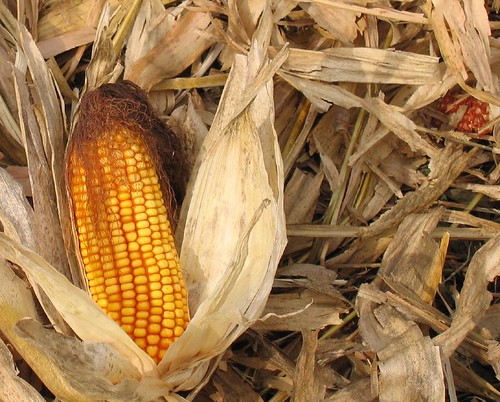
Golden ear of corn. Family farm in Woodford Co., KY.
(*photo credit)October 10, 2011 Indian
"Three Sisters" -- Corn, Beans, and Squash
On
Columbus or Discovery Day, it is wise for us to recount the many
blessings that resulted when Old and New World cultures met in the 15th
century. We hear of many forms of settlement when that meeting occurred, some
with benefits and some with unhappy outcomes. We hear of the spread of diseases
and horrible stories of exploitation; we also learn about the multitude of
benefits that include agricultural products and expertise. Corn or maize is a
major New World gift to the wider world along with tomatoes, potatoes, peppers,
tobacco, pumpkin, squash, and certain legumes. We may forget that Native
Americans used highly sophisticated techniques for producing plentiful supplies
of these foods.
The
"Three Sisters" included corn growing on stalks, beans climbing up these stalks
as though they were bean poles, and squash at the ground level acting as living
mulch to retain moisture and avoid weeds. The combination of the three was
ingenious and took sizeable land areas for plantings but did not require tilling
the entire surface areas. Where fertile land was in abundance, this proved to
be excellent cultivation practice that only required sowing and reaping in the
autumn. The produce that resulted all lent themselves to be dried and stored
for consumption during the winter months. Furthermore, Native Americans had
green-corn harvest festivals and introduced the world to corn on the cob. The
resulting beans and corn cooked together yield tasty succotash.
Native Americans were
introduced to the "three sisters" at different times; corn came about 800 AD and
beans about 1200 AD with the crops coming from tropical parts of the New World.
Cultivation of squash was far older (about 700 BC) and plants were more native
to the temperate regions. However, by 1200 AD and beyond the "three sisters"
held agricultural prominence, and led to more permanent settlements with women
being the ones who tended the crops. This was especially true among Iroquois
nations of the American Northeast.
I have raised the "three
sisters;" the combination works, but I discovered that my garden space
limitations does not allow for extensive cultivation. On small plots, it is far
more economical and prudent to grow salad greens, tomatoes, cucumbers, peas, and
other crops that do not take much space when judiciously placed (as does the
growing of corn). An added aspect is that the beans return nitrogen to the soil
and thus allow a balance in growing, though some fertilizing was part of the
Native American culture. People are unaware that these natives people
cultivated vast tracts of land (sometimes hundreds of acres) from upper New York
to beyond the Mississippi River valley. They either cleared the land or turned
Prairies into cultivated fields. The entire surface area did not require total
surface tillage -- a major labor saving practice.
Prayer:
Lord, teach us to be open to the lessons taught by primitive people and to learn
to respect their expertise in many areas involving ecological balance and food
production.

Fallen leaves collected in a broken fountain.
(*photo credit)October 11, 2011
Champlain's Dream and Lessons to Be Learned
As
of this initial writing in late spring, I have completed the audio-book,
Champlain's Dream by David Hackett Fischer. I listened to this while
driving and found that it is excellent for occupying time and a benefit for
those with limited reading time. In fact, I heard this ten-hour story twice and
found much more information the second time around. The book gives a respectful
insight into the early French explorer, Samuel Champlain. Rarely do I recommend
books, but this story is deeply impressive because of the tolerance Champlain
showed towards Native Americans, his willingness to live among them, to learn
from them, and to exchange the good of French culture. Even the word "savage"
does not have the pejorative tone we place on it today, but was derived from
silva, the Latin word for forest -- the woodland people.
The
dream of Champlain was so different from the savage reality of the European
religious wars with which Champlain had been involved in the late 16th century.
He was a loyal subject of his beloved leader, Henry the IV (Great), who treated
Samuel like a son. The death of the king set Champlain back in his efforts at
colonizing Quebec and the Canadian regions of the St. Lawrence and Acadia -- but
not entirely. Champlain's ability to bounce back was astounding, for no
adversity held him down. He gave his North American friends and the early
French colonists a willingness to overcome obstacles, in an effort to settle
what was to be Canada.
The
skills of this great explorer were enormous -- maritime shipping, military
leadership, fund-raising, gardening, map-making, governance in the colonies,
house-building, fortifications, and on and on. He was a human being and some
things did not work perfectly, such as his married life. However, Champlain's
sense of justice and integrity impressed both colonists and Native American
residents -- and the Sac and Fox continued an oral tradition of favorable tales
about this unusual European for two centuries even after they moved to central
United States. Champlain did not receive honors or monetary rewards of any
noticeable degree and he fell out with later French rulers and bureaucrats, but
he never lost hope.
Throughout
his three decades in North America, Champlain remained committed to a remarkable
Grand Design for France's colony. A leader who dreamed of humanity and peace in
a world of cruelty and violence, he was a true visionary, especially when
compared to his English and Spanish contemporaries. If Samuel Champlain were
living today he would support our quest for sharing the commons with all the
unfortunate of the world -- for he was a devout Christian with a global vision.
He was a man of his times; he accepted hierarchical monarchy but would have
valued today's democratic government, where all are regarded as equal.
Prayer:
Lord, teach us to listen well and to learn from what we hear as much as from
what we read; help us be aware of famous people of integrity such as Samuel
Champlain.
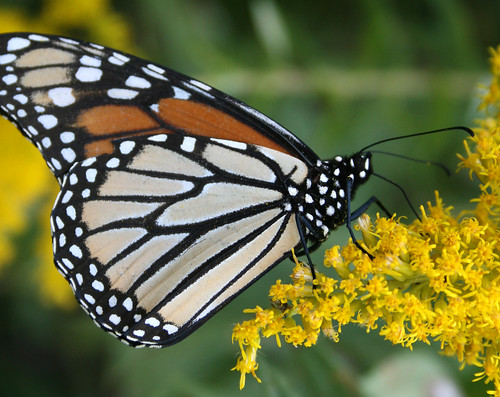
Monarch, Danaus plexippus, on goldenrod.
(*photo credit)October 12, 2011
Cumulating Small Earthhealing Acts: Good or Bad?
We
can reflect on doing small acts to heal our wounded Earth: picking up litter,
disposing of a container properly, or turning down the noise-maker. Good, yes,
but also bad? Sometimes.
The
benefits of small ecological acts are often enumerated on this website in
many ways: consciousness-raising on the part of the person to individual
and domestic resource use and conservation; negative awareness, namely,
wastefulness by others who may have to be reminded of their duties as consumers
to use resources properly; a growing sense of respect for modern technology
and its impact on the total environment; a grounding in concerns at our
local level; gratitude for a multitude of individual gifts given for my limited
use; growth in observational skill about the changes of nature's seasons
and conditions; opportunities for exertion in doing physical exercise in
constructive ways; and new ways of teaching others positive aspects about
our Earth. In little ways we grow spiritually, psychologically, and possibly
ecologically -- to a point; however this point requires discernment.
Risks
exist in doing small acts: we can miss the big picture by focusing on minutiae;
we can become satisfied with what we are doing in a self-righteous manner; we
can become critical of what others are doing or failing to do to the point of
irritating them; we can excuse ourselves of reaching out to others in parts of
the world; and we can avoid exerting and risky activities that challenge the
dysfunctioning economic and political system in which we are immersed.
As
a little kid I would daydream that if we had a house fire I would at least grab
my shoes and a fly swatter and run for the door; at least I could save
something. Then the thought came; how about helping to put out the fire?
Arranging deck chairs on the sinking Titanic no matter how perfectly executed
will not save the sinking ship. Then it begins to dawn that tiding up small
areas may have a ripple effect, and yet may not stop the hurricane that is
coming. Thinking globally and acting locally prepares us to do more, namely to
think and act collectively with others globally.
Small
acts, when offered in a global perspective generously and openly, lead to
grander acts on the spiritual plane. In fact, small acts can be transformed
into grander acts, and this is precisely what we are called to do in our
spiritual life. When united with the Lord, prayerfully and sacramentally, we
have a spiritual power to transform little deeds into bigger ones, deeds of
cosmic sacrifice -- and we have a responsibly to do so. We may have
opportunities to effect grander scale change, and the invitation stands to do
so. Our physical and mental efforts may be limited by age, condition, or
opportunity; our potential spiritual efforts can be immense if we think big and
act accordingly.
Prayer:
Lord, give us a sense of power found in being close to you, and to see that
through this power we can effect change.

Along the
Natchez Trace, near Tishomingo, MS.
(*photo credit)October 13, 2011
Nuclear Waste Disposal and Modern Mythology Day
A myth is a
traditional story (generally of unknown authorship) with some sort of historical
basis that tries to explain some phenomenon in nature (origin of Earth, animals,
people. etc.). We do not know the precise person who started the myth that
nuclear wastes could be properly disposed, though Elizabeth Dodson Gray once
suggested that it was begun by nuclear engineers who had never changed diapers.
Nuclear waste differs from a diaper in that it does not undergo rapid
decomposition -- for worrisome radioactive levels remain way past our lifetimes.
The Obama administration
authorized the Blue Ribbon Commission on America's Nuclear Future (BRC) not to
find a new site for the abandonment of the Yucca Mountain, Nevada radioactive
waste project, but rather as a method of coping with the current waste materials
that need some safe containment. Is "disposal" even the right word when
worrisome toxic materials remain for centuries? Amazingly, some of the expert
advisors to the BRC are more interested in continued generation of that waste,
not its termination; the operative principle with which that group works is an
expectation to make dirty diapers disappear -- but the won't.
When
Art Purcell, Mary Davis, and I were working on "Critical Hour" from 1988 to
2004, the question came to us over and over, how can we explain a safe solution
to the nuclear waste disposal issue. It remains an ongoing puzzle. When hot
spent-fuel rods are put for a number of year in water-filled, on-site pools at
nuclear powerplants, one still has problems (as the Japanese at Fukushima soon
discovered after the earthquake earlier this year); critical coolant can leak
out and refilling that pool can be difficult. Furthermore, these pools are open
to be sabotaged through terrorist acts as can, to a lesser degree, the
powerplants themselves. Earth Healing, Inc is part of the coalition of groups
that favor some basic environmental safety procedures:
* Stop generating
radioactive waste;
* Affirm that ending the
Yucca Mountain project was proper;
* Radioactive wastes more
than five years old need to be removed from the fuel pools and placed into dry
casts;
* The dried casts need to be
hardened to protect against natural disasters, terrorism, and unforeseen events;
* and there should be no
unnecessary transportation of radioactive waste to "interim" waste sites.
See <www.nirs.org>
These
elements are not solutions, only ways to handle a bad situation until a better
one can be developed. Hardening materials could be of such permanent material
that they will appear indestructible -- but it is the "appearing" that causes
the ongoing puzzle to remain unresolved -- and the myth of safe disposal.
Prayer:
Lord, teach us our limits and how we find these in problems such as nuclear waste
disposal.

Autumn bouquet.
(*photo credit)October 14, 2011 What,
the Devil? Is Evil Personified?
Is
it not time (after 2,100 reflections) to mention in a title the unfamiliar
subject of the devil? Or put another way, are some of us so afraid of
being ostracized for even considering this subject, that we avoid it? Would we
rather speak of "evil" lurking in our or other people's hearts? Are they right
who say that we will not talk of the devil because all spiritualities are good
in themselves? Is this introduction of the diabolical off limits for an
ecumenism of spiritualities? Did this author have to suffer the indignity of
being shunted to a special single-person session at the World Council on
Religion in Chicago in 1992 because he held there were evil spiritualities? And
is that not the price of defending the founder of the Jesuits, Ignatius of
Loyola, who championed the discernment of spirits -- and not all are good ones?
Should
we go a little deeper? Is it possible that the evil spirit spends time
assembling proof for the unwise that IT (I hesitate to say "he," and certainly
for the sake of sensitive females "she") does not exist? For is it not true
that if evil is personified, then our universe in some fashion has this presence
of evil relating personally to people in our midst, tempting them, and enticing
them to misdeeds and greed? Does this reach deeper than personal allurements
and temptations to excessive or inappropriate use of material things and
practices?
What about those of us who
are convinced that the current economic/political system is heavily under the
charge of the evil spirit who is somehow master-minding the entire
dysfunctionality that we perceive all to often? Is the devil behind the
profit-making, self-centered, greed-filled motivations of so many of the
brightest and most ambitious in our midst? Do people who are committed
materialists (and never talk about anything spiritual whether good or bad) fall
under the devil's sway while never averting to such a condition? Is this not
where God's power enters the picture and diabolic powers are battled by people
armed with spiritual instruments of grace furnished by the Holy Spirit?
Do these questions baffle
you as much as they do me? Have we been remise by speaking of "Spirit" with a
capital letter when we mean the "Holy Spirit?" Do we fail to acknowledge the
titanic battle of good and evil involving persons beyond ourselves? What about
this series of questions? Does it avoid the basic issue of the nature of evil
in our midst? Are we once again failing to face the reality that is all around
us, and a devil that we pretend does not exist? Is it not the diabolic purpose
to entice us not to believe in personal evil? In fact, should we pray that we
face reality, for that is the mark of authentic spirituality? In doing so, must
we go farther and say that with God's power we can be what we say, when we pray
in the Our Father, "Deliver us from evil?"
Prayer:
Lord, let my questions be proved helpful for me and for others, and help us
answer all of them as best we can.

Insect (Family Reduviidae - Assassin Bug) on thin-leaved coneflower, Rudbeckia triloba.
(*photo credit)October 15, 2011 Domestic
Ecology and Enthronement of Sacred Heart
Tomorrow
is the Feast of St. Margaret Mary Alacoque who helped promote the
devotion to the loving heart of Jesus through prayers and actions. One of these
devotions is the "enthronement" (placing in a prominent part of one's house no
matter how humble the place) of a picture of the Sacred Heart of Jesus,
whereupon peace is promised to come to that place. Such a simple procedure with
appropriate prayers is the start of establishing peace at our basic place of
residence, with the hope that from this location of peace a ripple effect will
go out to all the world. Here is a good example of acting very locally, so
local that it is within our home, and that the domestic ecology will influence a
broader one.
Some
ask a cleric or leader to come and conduct the ceremony or to give a special
blessing, though this need not be the case. The placement is itself the
important event, and all household members are to be alerted as to why this
enthronement is so important, as a source of peace and reminder of the respect
coming from all domestic dwellers. The basic prayer for such an enthronement
is:
Enthronement of the Sacred Heart
O God, bless this house
and all residents who live here. You desire that all who visit or stay will
help create a home where the love of Christ radiates to the neighborhood and the
world. Let this be a source of domestic blessing, a model for others to see and
imitate. Make this a haven for your divine blessings and change the lives of
those who dwell here so they are always mindful of the covenant of your Love
with us.
Most Sacred Heart, hear
these prayers. Through this blessing of the picture of the Sacred Heart, may
your likeness and the symbol of your love be engraved into the atmosphere of
this dwelling. Make this a holy place, one of peace as promised to St. Margaret
Mary Alacoque in 1674 as an important component of the devotion to the Sacred
Heart. Let all here cherish the honor of your likeness in this prominent place
for all to see.
Most Holy Spirit, guide
those who are devoted to the love of Christ to share that love, starting at this
Christian home and radiating out to all the world.
________________________________
Installer
________________________________
date
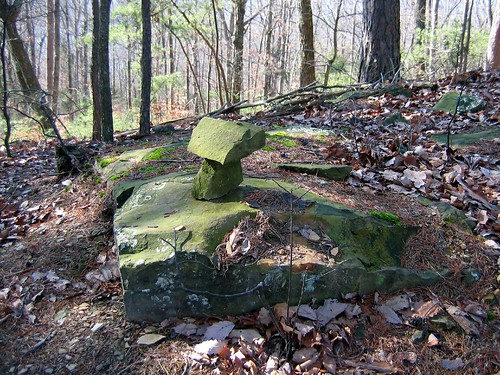
Findings in the forest.
(*photo credit)October 16, 2011
Render to Caesar
Give to Caesar what is
Caesar's and give to God what is God's.
(Matthew 22: 15-21)
The Gospel story of giving
to Caesar and God what is due to each occurs on Jesus' final journey to
Jerusalem. The two parties (Pharisees and Herodians) agree in one thing: to
reject Jesus as messiah and challenge his authority by putting him to tests.
Their hypocrisy is revealed when Jesus asks them to produce a coin, a tacit
admission that they really did use Caesar's coinage, though they refused to do
so in the temple. This was because the image of the emperor on Roman coins was
a sign of unjust authority and imperial godlike character. Moneychangers were
held in low esteem for converting dirty pagan money to temple coinage. Jesus
turns the tables on those who seek to trick him by getting them to admit they
had Roman coins in their possession.
Throughout history there have
been conflicts of church (God) and state (Caesar), of the right to practice
one's religion in the face of an authoritarian state, or the state siding with
one religion to force conformity on another. One recalls Thomas More, "The Man
for All Seasons," who tells why his love and respect for the king makes him want
to help the king keep his oath of office (Magna Carta), with respect to their
shared Christian faith. We could find instances of such choices down through
history and wonder whether we too have a financial and credit system that
borders on being a state religion of sorts; we too must render to both God and
to mammon without overstepping boundaries.
On the question of rendering
we recall that every gospel passage has individual and social applications. The
poor belong to God; to neglect the poor is to fail to give respect to the
Creator. We must respectfully ask: to whom does this Earth's limited wealth
belong? To those who have the power to take and retain it with laws on their
side? Or to those who have basic needs? Doesn't the "Cardinal Frings
Principle" (taking coal through "theft" when one is without fuel), still apply?
Must we choose between those who have tax privileges and exemptions, and mothers
and children on WIK programs? In this year of threatened financial default and
higher demands for curbing debts, we need to ask very basic questions.
The people of this world
can be good at heart and show this through inspired actions. The ruler Cyrus
(Isaiah 45: 1,4-6) was just in dealing with the people in exile and recognized
their national aspirations and their desire to return to their own homeland.
Today, millions of refugees would like to return to their homelands but they
have no work opportunities. Amid the financial crisis that faces us, we know
that the opportunity to earn one's livelihood must be given a high priority.
Ultimately, disrespect for human beings is disrespect for the Author of life.
Prayer:
Lord, help us to learn respect for what and to whom we render deference. Let us
see the poor and unemployed as worthy of respect and special attention during
difficult times.

Fruits of the persimmon, Diospyros virginiana, native Kentucky
tree.
(*photo credit)October 17, 2011
Observe World Food Day
These
Daily Reflections have said much about food, especially during October
and November, 2010. What does "observing" mean on this special day? Attending
a festival? Preparing a nutritious meal? Feeding the hungry? Contacting a
legislator's attention to world food insecurity? Recalling that the world's
population will climb and level off at nine billion by 2050, with demands to
double food production by mid-century? Reflect on these hints as well:
*
Never waste food or allow others to do so if at all possible. Some say
half of the world's food supply disappears "between field and fork" -- enough to
eliminate world hunger if properly utilized. During the course of a year,
Americans waste 22 of 77 lbs. of fresh fruit purchased, 36 of 173 lbs. of grain
products, 39 of 131 lbs. of fresh vegetables, 27 of 70 lbs, of poultry and 43 of
168 lbs. of milk, 4 of 28 lbs. of cheese, 0.7 of 5 lbs. of butter, 4 of 26 lbs.
of eggs, 0.9 of 9 lbs. of nuts, 4 of 15 lbs. of fish and seafood, 36 of 103 lbs.
of red meat, and 24 of 121 lbs. of sweeteners. National Geographic,
July, 2011.
*
Turn lawns and yards into edible landscaping for vegetables, herbs,
fruit, berries and nuts -- and do so tastefully;
*
Eat less meat, for this meat requires far more resources than consuming
the feed that goes into animal products indirectly, and thus make available more
grains for hungry people;
*
Support a teach-in for healthy foods, especially at school cafeterias and
other institutional establishments;
*
Resolve to grow more of your own garden produce next year, and to extend
the garden's productivity well into the autumn and even into early winter;
*
Preserve excess food supplies for your own benefit and that of neighbors
and loved ones.
*
Lobby Congress to eliminate subsidies for food-derived biofuels that are
using 40% of this year's American corn crop, and ask that through converted
subsidies this grain can be stored for human use in times of famine in various
parts of the world;
*
Attack local malnutrition as well as that in other countries, and insist
that solutions to problems for the poor be found and have funding in an age of
financial difficulties; and
*
Pray and work that food security will be given equal if not greater
funding than military security -- and to see that various forms of insecurity
are related.
Prayer:
Lord, give us a sense of food consciousness, not just for what we eat but for
what we waste, grow, preserve, and share with others who are in need. 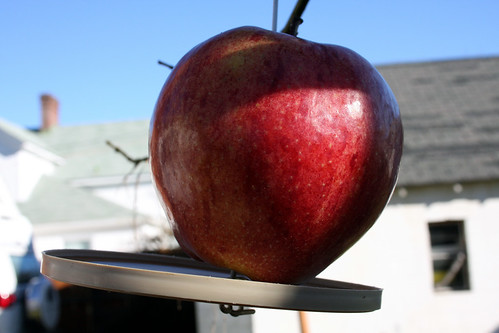
An apple for the birds.
(*photo credit)
October 18, 2011 Food Insecurity,
and Terrorism
In
early summer when this reflection was first drafted the BBC reported about the
hunger affecting ten million people in the horn of Africa; the reports spoke of
one mother abandoning her family of six kids because she could not face watching
them die of hunger. Is this the terror of hunger? At the same time two-thirds
of the needed funds to meet this year's drought in that part of Africa were
still lacking -- but the amounts were less than one day's expense of what our
country spends on combating anti-terrorism. What if we were to give some of
that funding to combat real terrorism among hungry millions in Somalia or
Ethiopia?
In
yesterday's food day we reflected on wasted food -- that which is prepared for
food but never eaten, but tossed away. What if -- the corn that were used this
year to make ethanol for our energy-wasting vehicles (and driving practices)
were left as bulk grain, and this material used to alleviate hunger in drought
affected parts of the world? Waste creates an atmosphere of insensitivity that
distances us from people who suffer the terror of hunger each and every day.
Insecurity comes in various ways. For some, it is not having the means to keep
the family alive in harsh conditions; for others who are caregivers, it is not
having supplies to feed those pounding on the door; for still others, it is the
lack of sufficient petroleum to fuel vehicles; for others who are traveling, it
is the threat (though somewhat remote) that some angry person will blow himself
up on our plane if he can get past security barriers; and still for many of us,
it is our own insensitivity to the essential needs of our neighbor in other
parts of the world. In the last case, insensitivity breeds and accelerates
insecurity.
Security
is an evasive issue. Security means a feeling that we are protected by
like-minded and vigilant people; it involves interrelatedness and generally
rests within a local vicinity, a home, or domestic surroundings. The growing
connectedness of our world resulting from Internet and instant communications
makes us aware of the planetary extent of our neighborhood. Thus insecurity in
one place affects others of us in another part of the world. A failure to be
with others in time of need is creating a new threat to world security that goes
beyond military preparedness and financial concerns; it involves the growth of
social awareness.
This
is a wake up call. If such global security breaks down by our insensitivity to
fellow human beings in need, then are we the cause of the hunger in some degree,
and are we party to the terrorism that is experienced in the hearts of the
Somali lady who abandoned her kids when she had to escape watching them die of
hunger? Just as security comes in many forms, so does terrorism, and what we
seek to avoid is individual terrorist attacks on innocent people in all places.
This is Food Day plus one.
Prayer:
Lord, teach us to see hunger in its raw intensity as it affects others, and to
become truly compassionate people.

(*photo by Digi Pig, Creative Commons
   Some
rights reserved) Some
rights reserved)October 19, 2011 Visit
the Martyr's Shrine
Martyr's Shrine is sacred
ground where people of many nations and cultures gather to enter into communion
with those all over the world who sacrificed their lives for faith and for
justice.
Mission
Statement of Shrine
Earlier this year Mark
Spencer and I visited the Martyr's shrine at Midland, Ontario. This site is
related to early Jesuit mission efforts, and I spent a formation period in 1968
at Auriesville, New York, the site of three of the North American martyrs' place
of death. Near Midland is the Ste. Marie settlement, the site where two other
of the eight Jesuit martyrs (John de Brebeuf and Gabriel Lalemant) were killed
in 1649, and near where the others met their martyrdom.
The shrine is located one
hundred miles north of Toronto. It is open to visitors during the warmer
months. The grounds are easily accessible and well-kept with flowers, ample
parking, good walkways, souvenir shop, educational center, nearby reasonable
lodging, cafeteria, and a shrine with daily services during the warmer months.
Special attractions include memorials and altars located around the grounds
dedicated by ethnic groups in honor of their own martyrs and religious leaders.
The graves of Fathers De Brebeuf and Lalemant are within the reproduced
palisaded village/religious center across the main road adjacent to the shrine.
Water and land touch, water as means of travel and commerce for 17th century
Jesuits, and land where Hurons lived.
Huronia's Gifts
Darkness retreats on
summer's longest days,
when first light
contests the night;
A gold-pink streak,
illumines verdant lands
imprinted with
sapphire hands of waterways.
It is an unfolding form,
an instance soon gone,
a sight to behold by
early birds,
A moment of fleeting
grace, fulfilling place,
a loon's cry
announcing the new-born dawn.
Thus comes streams of Good News,
enhancing color,
bringing on what's bright,
Relentlessly new day
drinks in the shadows,
as pale and varied
hues the rays defuse.
Blackrobes
from the East overcome strife,
bring gifts of light,
find abiding light,
taking and sharing with
those present
mortal blows to usher
in eternal life.
Prayer:
Lord, inspire us by the sacrifices of martyrs to be to be enlightened to see current
difficulties as divine gifts.
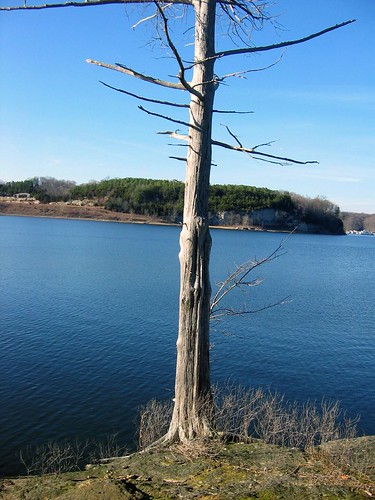
Still standing. Russell County, KY.
(*photo credit)October 20, 2011
Witnessing as Long-Term Spiritual Investment
Uneasiness
creeps in as we reflect on the life of martyrs. That was the same ill ease I
experienced in grade school when reading about the painful deaths experienced by
Isaac Jogues and the 17th century North American martyrs. Why did they
sacrifice at relatively young ages with little success in sight? Yes, they were
people of deep Christian faith, and they wanted others to share that faith with
them. If a martyr is a witness to the Lord, power rests in witnessing, and
that power extends to future generations. Thus, part of the witnessing is not
for immediate results but as a long-term spiritual investment.
Why
was Osama Bin Laden buried at sea earlier this year? Chalk that up to bypassing
a potential martyr's shrine. Terrorists seek to influence others through
blowing themselves up for a cause, even though the other victims are quite
innocent. We would say in one instance that this is a waste in so many ways,
but it does show that others in desperation regard their own lives as worthy of
being sacrificed as an investment for change. Truly suicidal "victims" may be
drugged or seduced into such acts and, in one sense, they risk weakening the
power of their witnessing as much as strengthening it -- for witnessing can
always be misunderstood.
In
the North American martyrs' situation, many Christians would regard their
sacrifice as a power that continues down in time to our day. Perhaps radical
Moslems would say the same about modern suicide attacks. Dramatic actions are
costly. Can we witness in alternative ways by willingly doing ordinary
sacrifices, that is, making a living and sacrificing for those who come after
us. The quiet witnessing of good people is part of that spiritual investment,
that being willing to do less dramatic but equally meaningful things that
witness to the power of sacrifice.
Salman
Taseer, the governor of Pakistan's Punjab state was assassinated by his own
bodyguard at the beginning of this year; the governor publicly supported reform
of the nation's blasphemy laws when a Christian woman was falsely accused of
blasphemy against Mohammed, a capital crime. She had refused to convert to
Islam and was denied access to the village water well. In defending her, Taseer
was shot dead and the assassin was regarded by some (a question of how many) as
a hero. The martyr was standing for the basic rights of an unfortunate citizen
-- truly an unusual martyrdom -- though all are to some degree. Taseer's
daughter resolves to carry on her father's efforts even though it is an
unpopular issue in highly- charged Pakistan, where her own life will be
threatened. Hopefully, by hers and others' efforts, such blasphemy laws will
be repealed.
Prayer:
Lord, teach us the true worth of sacrifice and witnessing, and give us the
chance to do this in undramatic ways for the benefit of everyone now and in the
future. Help us to give honor to those who deserve it and to learn lessons from
all who die in testimony to what they believe.

Pokeweed, Phytolacca americana, reclaiming the garden plot.
(*photo credit)October 21, 2011
Respecting Limited Garden-Space
Becoming
aware of space is a variant on a number of previous reflections dealing with
(outer) Space Week, sacred (respectful) space, and proper use of (storage)
space. On this evening when we could observe the Orionid meteor showers,
we can become more conscious of the vast space out there, the living space in
our homes, the acceptance of audio space to play music, space to be private,
pray, cook, or space to walk about. Early this morning the classical NPR music
station announcer suggested that one point a loud Wagner finale at a hard
rock-playing neighbor. No, this will NOT promote respect for (audio) space.
Let's
consider respecting limited garden space, for ignorance, inexperience, or
failure to be tidy may waste opportunities to grow more produce. Some plants
such as corn take much space and so we accept that fact and plant something
else. Space-conscious people consider the following:
*
Know what grows over a period of time, for an immature tomato plant can take up
little space when inserted into a row of greens or radishes, and then in summer
require more space after the first crop is harvested;
*
Select veggies that take up less room on the ground. Cucumber, squash, tomato,
or grape vines grow with little ground space needed if allowed to be trellised
or staked. They will need fertilizing and watering even when other crops become
living mulch;
*
Realize that grape arbors can serve as growing area and yet the space beneath
can be good sitting or ever storage areas, especially when garden and
recreational space is at a premium;
*
Potted plants can be kept indoors longer or adjusted to various places as
earlier plantings are harvested, and thus space is used at all times at a
maximum;
*
Know the sunny and shady conditions of your garden space for this makes for
greater productivity. A cucumber can thrive in near shade; beans cannot.
However pole beans can be selected so as to climb above the shaded surface under
proper engineering;
*
Forget about pumpkins (they take much space) unless they are permitted to spread
over unused pavement or lawn;
*
Roof gardening has potential provided a strong roof; and
*
Consider sequential gardening, e.g., spring greens, summer melons, autumn root
crops. Even in temperate zones, we can grow crops using protective coverings
well into early winter and beginning in early spring. Make allowances for
hardiness.
Prayer:
Lord, give us the wisdom to see that all gifts -- even our space -- has limits
demanding creative use.

Lake Barkley at Land Between the Lakes.
(*photo credit)October 22, 2011 Placid
Environmentalism: Pale Green or Yellow?
Leaves turn from green to
yellow at this season, and maybe the same can be said for attitudes about
earthhealing, if we are not careful. On August 8, 2009, our Daily
Reflections discussed "green" being used in many ways: envy, foliage, and
environmental practice. Various degrees of greenness exist: preservation of
aspects of creation through education, regulations, and enforcement and
conservation practice; accepting that we are to blame and take individual
conservation measures to heart; and ultimately entering solidarity with our
fragile Earth and taking all measures needed to halt the destruction occurring
all around us. Here greenness means using well all the gifts at our disposal --
in an experienced way.
Each
degree of green beckons to deeper involvement. To say that culprits are to
blame is a distant call to change; to say I "recycle my waste" begs the question
as to whether I consume too much of what causes the waste; to say that I hug a
tree may not include concern about climate change that threatens that tree.
Green practice may be the excuse that one has done enough, and thus fails to
move beyond individual satisfaction to the social dimension of delving into the
causes of the environmental crisis: tens of millions in China, India and other
emerging nations are increasing their appetite for the very resources, the
extraction and processing of which have damaged the planet during the last
century. Their degree of greenness is to be questioned.
True
solidarity deepens the color green when it hears the cry of the poor -- yes,
poor people and poor Earth, a social justice issue, for our resources belong to
all, not just to be as privileged. Placid greenness is to fixate on some
individual practice and omit that deeper and troubling social dimension. It is
like arranging chairs on the Titanic, or singing songs in a canoe drowning out
the roar of the upcoming waterfall. Placid greenness in such areas as use of
food materials for biofuels, nuclear power as "clean" energy, and carbon trading
practices (previous reflections) are not really green at all. Other practices
are good in themselves if one does not become so fixated that this or that
practice consumes inordinate amounts of time (e.g., specific food selection and
preparation). "Placid" or faded green means never calling into question the
dysfunctional system that causes the environmental crisis. The hesitancy may be
due to fear of being different, ostracized, regarded as radical, or being a
party-pooper while the canoe hastens to the unknown waterfalls.
The
question of any treatment of green environmentalism is how serious does one
intend to be. For the status quo seekers, it appears enough to give lip service
to Earth, and take on one or other practice that never threatens the system and
makes others regard you as a conformist in the comfortable sense. This is when
green turns to cowardly yellow.
Prayer:
Lord, strengthen our courage so that we take the responsibility to learn the
causes of the environmental crisis.
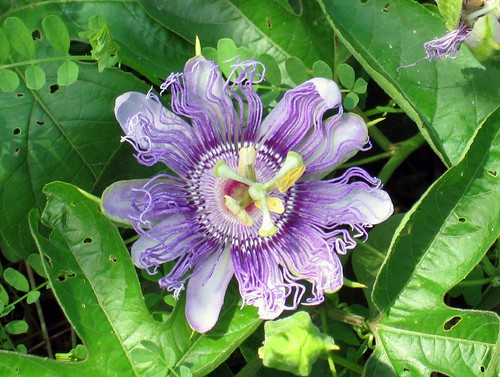
Passiflora incarnata, passion-flower, in early Autumn.
(*photo credit)October 23, 2011 How Do
We Love God with Our Whole Heart?
You must
love the Lord
your God with all your heart, with all your soul, and with all your mind.
(Matthew 22:37)
Jesus
says we must love God with everything we have, but how do we give all, and how
do we know we have done so? The "must" baffles us in some ways. We each know
that love is necessary in our lives, and that to love God is the very first
lesson of the Catechism. We say it. Jesus interconnects this love of God with
love of neighbor, thus showing that the testing of our heart comes in our
outward treatment and attitudes to our neighbor.
You
must love your neighbor as yourself. (Matthew 22:39)
This
love of God/neighbor is more than pious words, or rote prayers, or automatic
answers to the primary catechism questions. Love involves meaningful deeds,
even to those we dislike. We gradually learn that misdeeds speak loudly about
our degree of loving others. Deeds, when done with sincerity and fidelity, give
quiet assurance that we love what we are doing; we come to know where our hearts
are at a given time and that allows us to assess our love life. Our neighbors
tell us how we love our God, and the greater the love we show, the stronger will
be our grounding in the love that Jesus says we "must" have in loving God and
neighbor.
Yes,
we never love enough and so our efforts ought to be to deepen our love -- but
how? At the Last Supper, Jesus gives his disciples and all of us a new
commandment, to love as he loves. Thus our love must imitate that of Jesus, the
most perfect model of love. We read the Scriptures in order to see his deep
respect for others, extending healing to the sick, teaching and ministering even
when he is tired, and suffering and death for all in the most forgiving manner.
Jesus' deeds involved a surrender to the Father. The goal of our love is the
Source of all love, God. God gives us the power to love, and thus we surrender
to God when we seem too powerless to love. Alone we love little; with God's
help we can dive into the ocean of divine Love, and allow that ocean to
penetrate our entire being including our hearts. This infinite sea of love
contains a compassion that goes out to all our brothers and sisters. We are
able to enter into the sufferings of others as though they were our own, and
thus we can love others as ourselves.
We thank God for the power
to love others, and thus we do so willingly even when it is difficult. If we
accept that our love involves God AND neighbor, we realize our advancement in
love requires another. We can only love others fully if God gives us the grace
to do so. Our surrender is the key to our advance in love. Growth in love is
based on growth in openness, and here we continue on the journey to godliness
with the Lord.
Prayer:
Lord God, who is Love, teach us to love. Touch us and allow us to see that love
grows as we surrender and not as we seek to do more and more through some inner
efforts apart from you.
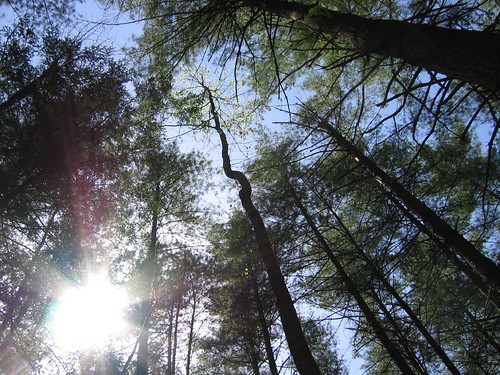
A view from the forest floor, Red River Gorge, KY.
(*photo credit) October 24, 2011 United Nations Day 2011: Year
of the Forest
On this United Nations
Day we recall that the world body has declared forests the area of attention
during this year 2011. This is an important consideration due to the dramatic
decline in global forest cover during the period after the Second World War, and
well into the 21st century. About half of that cover worldwide has been removed
or degraded due to unsustainable timber harvesting, clear cutting for grazing
and farm land, and other forms of development. While we are aware of the need
for the forest commons on a global scope, many of us still do not realize the
seriousness of the threat through so-called "development." Forest destruction
is slowing down as developing (and developed) nations appreciate the value of
existing forests and how precious and delicate they are.
Hopefully
after the Cancun, Mexico climate-change conference last December, the world is
more inclined to assist developing nations in saving their forests, the "lungs
of the planet." However, it is highly problematic whether that assistance ought
to be in the form of carbon-trading schemes (quite hard to determine true
trading value) in the Reducing Emissions from Deforestation and Forest
Degradation (REDD) scheme. Far better would be a program to tax extractive
practices and plow that money back into forest preservation programs.
Earlier
this year I promised my friends Paul and Pat Gallimore that prayers would be
offered for their son Yanu who was in the thick of fighting fires for the U.S.
Forest Service. Our country has been plagued by the worst set of forest fires
in our memory, and he and all the fire fighters need divine protection.
Extended drought conditions, especially in the earlier part of this year, along
with accumulated thatch and diseased trees in many forest areas, coupled with
lack of protection barriers, have led to enormous fires in Arizona, New Mexico
and other western and southern states.
We all need to protect forests as best we can. My parishes are located in the
Daniel Boone National Forest service area, with portions owned and the entire
area under the protection of that federal agency. This is part of what the
noted biologist Lucy Braun called "the Mixed Mesophytic Forest," which is the
oldest and most varied temperate forest in the world. Our efforts over the
years at the ASPI Nature Center was, and still is to teach students respect for,
and pride in this immense and rare treasure. This is to counter the propaganda
by commercial interests that forests are only of extractive (timber) resource
value. Once people see the priceless nature of our forests, they value them as
worth visiting, hiking within, and protecting from damage in any fashion. In
fact, commercial tourist potential far exceeds the resource extractive value and
this is gradually becoming known in Appalachia.
Prayer:
Lord, help us see the true value of our forest and to respect and protect them
as brothers and sisters in this threatened world.

Lily pads in autumn, near Cadiz, KY.
(*photo credit)
October 25, 2011 Disarmament Day: Do Away
with Nuclear Power
In
one way or other, to want to disarm a world is quite wishful thinking, but in
truth the goal is not totally idealistic. Think of conversion of one and a half
trillion dollar military budgets to world health and food agencies, furnishing
enough food for a billion destitute people and the health facilities needed to
care for two billion of the world's poor. World security would be greatly
enhanced -- and there could still be defense money for local police forces.
Costa Rica has no military. Why not us?
We feel guilt associated
with the Hiroshima and Nagasaki atomic bombing of 1945; we know that disarmament
is only part of the total program and that, ironically, a quicker approach may
prove to be getting rid of nuclear power-generating facilities -- the
powerplants using -- and needing -- nuclear fuel. If a guilty nation promoted
atoms for peace, let it be one of the first to abandon this form of electricity
generation ASAP, for preparing materials for power generation is to tap the
very sources for bomb material. The fact that several nations, namely, Germany,
Switzerland, and now Italy are already taking these steps could be a stimulus
for all countries, even those with nuclear armaments (U.S., Russia, UK, France,
China, India, Pakistan, Israel, and North Korea). However, the last one is a
rogue.
Fossil and nuclear fuels
have been heavily subsidized. Since the Second World War, nuclear power has
received as much in subsidies each year from 1950-90, as wind power received in
its entire subsidy until 2007 -- or $3.75 billion. This favoritism has highly
skewed the total energy picture to such an extreme that the general public has
come to believe that non-renewable fossil fuels and nuclear power were actually
cheaper. This is a bold-faced lie that the energy propagandists sought to foist
on a gullible public. Without federal subsidies --
wind would be
6 to 7 cents per kilowatt hour
coal would be
9 to 32 cents "
nuclear would
be 11 to 20 "
Why support fossil fuels and nuclear power if the total expense is so great?
Are these groups supporting governmental interference with markets at a time
when they rage against it? The fact is that wind is far cheaper than other
types of power once environmental costs are incorporated. Wind does not always
blow, but an associated energy source could be natural gas or even wind-driven
pumped storage systems. However, disarmament is more than transition to
alternative energy sources. Turning a world peace dividend into health and food
improvement will have multiplying effects in our war-weary world. Cutting
military budgets worldwide would get a jump start if we cut the U.S. military
budget, half the world's total. Nuclear weapons and powerplants must go ASAP.
Prayer:
Lord, give our people the courage to cut military expenditures and to utilize
funds saved for global improvements and far greater food and health security.
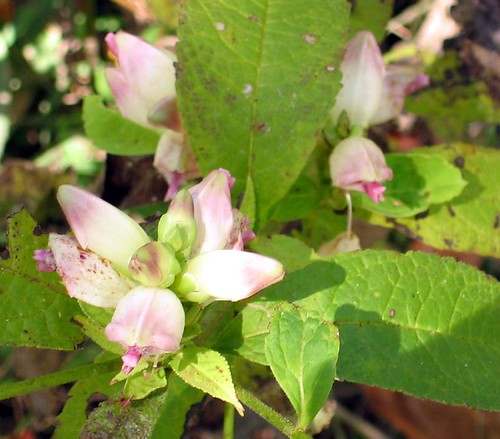
Turtlehead, Chelone glabra.
(*photo credit)October 26, 2011
Playing Games with Ecological Issues
You
are a party pooper for breaking up our electronic games.
"I'm
sorry but the house is on fire and it would be good to do something about it."
Some
of us get the impression, when we hear people pondering whether they would do
something about recycling, that they fail to see the depth of the environmental
crisis. More of us are to blame because we treat the public as though they are
kindergartners. We permit some to complain about higher-cost environmental
regulations and other to become environmental crisis chasers without doing more
than re-reporting bad news. How do we get them to see that we can't play games
with mother nature; energy-guzzling devices and vehicles are adult substitutes
for toddler toys at a time when all of us must mature and take environmental
matters seriously.
Earthhealing
is serious business. To make light of pollution or climate change is to act
immaturely at a time when people ought to get serious. Certainly
over-seriousness can hurt causes; some humor is needed for contrast and relief.
Earthhealing
involves big issues. The plea of many is that they cannot handle any more
issues, for their plate is full. True, but they will need to pick and choose as
to what information to focus on at a given time; however, don't belittle the
environment.
Earthhealing
will extend beyond my time. Our mortal span is not the ultimate criterion
of which to focus. In fact, most issues will not be totally resolved during our
lifetimes, but that is not an excuse for busying ourselves with short-term
successes.
Earthhealing
can become game-play under certain conditions; however, it is not all fun
and delight. Many like to engage themselves with artificial puzzles. Fine!
Others prefer real ones. The work of healing our wounded Earth is difficult
and involves all the talents we can muster in order to win -- and here we can't
afford to lose, for the poor and destitute depend upon us.
Earthhealing
leads to positive solutions. All too often the manner that youngsters are
introduced to ecological issues implies that it is more facile than it really
is. Fun and games have their place, but a burning building is worth saving
through fire-fighting teamwork, and saving the building is a positive goal.
Earthhealing
is a maturing process. Youth like to feel that they are regarded as adults
on occasions -- and ecological issues invites the participation of all. Whether
it is tree planting or trail upkeep, concrete results are experienced by each
participant.
Prayer:
Lord, teach us to be serious about saving our wounded Earth, but with humor to
see that we cannot do it all ourselves. Help us to learn to work with
others and to experience success at least to some little degree.
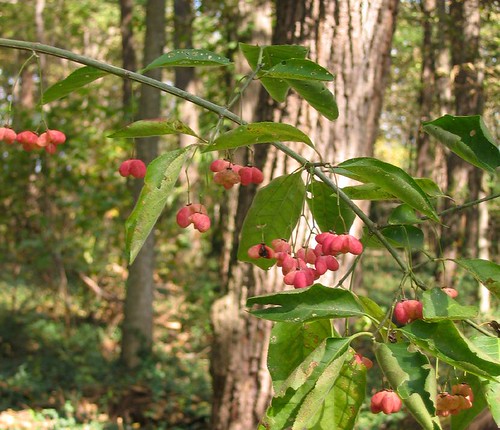
Eastern wahoo, Euonymus atropurpureus.
(*photo credit)October 27, 2011
Seed-Saving Programs and Endangered Species
Seed-saving
is now becoming popular in order to promote heritage varieties. These are in
danger of being lost by the rush to grow a small number of desired varieties of
everything from grains to apples. The stampede to conformity tells us sad news:
90% of the grain varieties used in China less than a century ago have
disappeared; of 8,000 varieties of livestock some 20% are endangered or already
extinct; of 7,000 apple varieties in the 19th century fewer than 100 varieties
remain. Alarm is being raised and some are trying to address the issues. ("Food
Ark," National Geographic, July, 2011, pp. 108-131).
Causes for species decline
are multiple, but one problem is that a few of the developed "miracle" varieties
of the twentieth century have become so popular that others (especially local
varieties) have been abandoned with the race for greater yields and more desired
products. Local seed-saving and reuse has gone out of fashion, to the detriment
of biodiversity that took ten thousand years of painstaking domestication to
develop. That diversity is needed to meet the demands of new (climate change)
or old (Irish potato famine of the 1840s) conditions. Climate changes will
challenge certain popular varieties in yet unknown ways whether by hot or cold
temperatures, drought or overly wet conditions.
This
stampede to new varieties in the past few decades has been fraught with dangers
of a global nature, and preservationists are trying to make us aware of hidden
dangers. In response to species loss, some have started projects to store in
safe places the diverse seeds that are threatened or endangered -- and could go
extinct. Preservation of stores of such species was first conceived by the
Russian botanist, Nikolay Vavilov in the 1920s, who envisioned centers of plant
origin to be established at various key places; Vavilov died of starvation in
1943 in a prison, a victim of Stalin. Heroically, others have taken up the idea
of regional and global storage facilities and the Global Crop Diversity Trust
and others are gathering specimens and storing these in safe places. One is
Norway's Svalbard Global Seed Vault -- a massive undertaking embedded in the
permafrost of a sandstone mountain on far northern Spitzbergen Island.
Seed-saving
at a local or regional level is now becoming popular by those who want to
preserve heirloom varieties grown by their grandparents and ancestors. One can
find examples on the Internet of exchange programs near to your home. We
consider this local act as an important part of a community of diversity lovers;
participation teaches respect for heirlooms, especially where flavor and growing
conditions were prized in earlier times. Arguments for diversity extend beyond
flavor to maintaining the food-growing potential of our planet.
Prayer:
Lord, teach us to respect the efforts of our past, the patience of farmers who
domesticated our flora and fauna. Help us to see the value in preserving these
as well.

Microkarst outcrop in western Kentucky.
(*photo credit)
October 28, 2011 St. Jude,
Patron of the Impossible: Earthhealing?
Today is the Feast of
St. Jude, the patron of hopeless causes and hospitals. However, we know
that nothing is impossible with God -- and that gives us courage in dreaming of
healing our wounded Earth. Still, we realize we must do all we can possibly do
to bring about success while depending also on divine help. Teamwork is at the
heart of our Earth-saving endeavors. What we often overlook is that the success
depends on a community of participants -- the noble caregivers of Earth, and
also the culprits who are hurting Earth at this time. People must change their
ways and become part of the team, and that depends on cooperative efforts.
Freely assisting is always the best way, but at this time we do not have the
luxury of waiting until others decide to respond -- for they may obstruct our
efforts. Coercive action may be needed.
Changing
insensitive hearts is part of the game plan, and all heaven is called upon to
assist with the task. Some throw up their hands and say "that is impossible."
People have shared with me dire personal situations with no immediate solution
in sight. That is always where God enters the picture -- and we ought to see
that moment as an invitation for divine assistance. My only recourse when the
situation seems beyond hope is to encourage the waning of heart to pray to St.
Jude, the patron of the impossible.
Poor
St. Jude was so forgotten (or rather ignored) because of sharing a name with
Judas (same name in languages other than English and French), the Lord's
traitor. Jude may or may not be the author of the Letter of Jude, or the
one mentioned as being the "brother" or cousin of the Lord as found in Mark
6:3. Through millennia, many Christians shunned Jude when calling on the saints
for help. In recent decades some regard Jude as the saint of last resort -- and
his recent intercessory power appears.
Patron of Earthhealing.
Jude (also called Thaddeus in Mark 3:16-17 and Matthew 10: 2-4) is only
mentioned briefly in Scripture (Luke 6:16; John 14:22 and Acts 1:13). Jude
takes a more hidden back seat role but still is patron of both hospitals and
hopeless causes. In his healing role, Jude may be a possible patron for our
seemingly impossible earthhealing efforts. Each saint is shown with symbols in
place of proper names on images or statues. Jude's symbols are a square or a
rule (designer and builder), a club (was it to entice people to change their
ways?), and a sword (for he was regarded as martyred and thus this expresses
being a witness for the Lord). In fact, Jude stands out as a person taking the
Good News to distant lands (in tradition to Persia and Mesopotamia), to plan and
design what needs to be done, to entice others to join in the participative work
ahead, and to help bring about what seems an impossible task. Shouldn't he be
the patron of earthhealing?
Prayer:
Lord, help us see that the ability to dream can be accompanied by the energy and
design needed to succeed in healing our wounded Earth -- and allow us those
resources like St. Jude to help with the seemingly impossible tasks ahead.
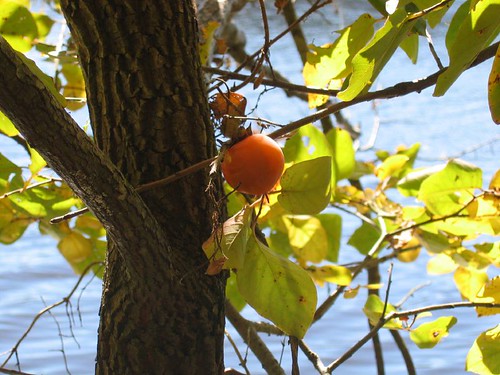
Ripening persimmons on the tree.
(*photo credit)October 29, 2011
Navigating One's Good Name in Credulity's Shoals
As might be expected, we
cherish our own good name.
Credulity's
shoals are the many places where the tendency to believe just about anything
can snag most people: Twitter accounts and Facebook pages; cell or land phone's
first rumor; 24-hour news coverage desperate to compete for information
overload; people willing to shave others down to their own small size.
A
Good Name, whether mine, yours, or another's, is fragile and takes a long
effort to establish and preserve. Once, when asked to review an environmental
report, the publisher asked whether I found any potentially libelous
statements. My first impulse was to say it was straightforward reporting; on
second thought, one supposed whistleblowing victim identified by the report's
author was reported to have been blacklisted by an unnamed but specified county
official. With little effort, the time and place of victimhood allowed
virtually any reader to pinpoint the alleged culprit if so desired. In fact,
having been acquainted with the victim, it was my suspicion that the
blacklisting did not cause the lack of job, and a potentially identifiable
person's good name was threatened by off-hand excuses publicized by a sloppy
reporter. Good names are inadvertently sacrificed at the altar of good stories,
and that calls for caution by all of us.
Navigating
the boat of our own business requires us to steer skillfully when considering
the fragility of others' cargo of good names; these names are easily damaged by
an offhand remark, a raised eyebrow, or the desire to elicit a laugh at the
expense of another. To navigate takes respect for the roughness of the waterways
of communication that can broadcast rumor or falsehood or even unneeded true
facts far and wide. People are in an age of incredulity and have ears trained
for something new and first ahead of others. Consumers of information are open
to shaving another person down to size. To stay clear of just such dangers
requires a skillful pilot -- and each of us is asked to do just that.
Good
names are needed for healers as well as the ones being healed. Earth's good
name must be preserved and enhanced at all costs, as ought the flora and fauna
flourishing here. To protect such good names may actually make us the butt of
jokes -- but such is the risk. Widespread respect for the good name of all
creation is the first level of defending good names; our halting the spread of
rumors is the second; our public refutation of destructive tendencies may be a
deeper level needed at times. A good name is a resource that can be easily
damaged or destroyed with little effort, even by people who dismiss others due
to a "credible" allegation. Tides run forcefully and our skillful steering of
the boat of respect means avoiding damage to another's good name.
Prayer:
Lord, give us the insight to see when we can enhance another's good name, a
precious jewel in a raging tide, and to find opportunities to protect their
names from inadvertent damage.

An explosion of October's peak foliage.
(*photo credit)
October 30, 2011
Practice What We Preach
In
the Gospel passage we read today (Matthew 23: 1-12), Jesus says to observe all
that the Pharisees teach but not to follow their example. All their works are
done to be seen, and they place heavy burdens on others, while they themselves
do not lift a finger to help. They do not do what they preach. In the back of
our minds we wonder, do we suffer on occasion from the same fault; do we expect
of others what we do not do ourselves?
Preaching
is a tricky subject, especially for those of us who write and encourage other
people to do good deeds. Without adverting to it, do we restrict our preaching
or overextend the issues beyond our own personal actions? When preaching much,
it hard to be perfect and this admonition extends from moral leaders to
representatives in all forms of government, to representatives at the UN, IMF,
World Bank and on to all civic, educational and business leaders. In fact, it
applies to parents and caregivers, from shopkeepers to manufacturers. Really,
it is true to say that everybody preaches through both word and deed; all say
things and fail to live their words perfectly; many fail to see that even
silence, when we need to speak is its own preached word.
On occasions, I am asked to
speak on simple lifestyles. My inspiration is from my parents who practiced
what they preached: living simply, having a relatively small house and few
luxuries, working hard, and furnishing us mostly homegrown food. Practicing
what was preached to me in youth is still a lifetime challenge. We need to
constantly reexamine what we say we do to remain environmentally green and how
we put this into practice through conservation of resources. Americans find it
hard to preach simple living because there is so much inbuilt waste to our
lifestyles. Some of this is inadvertent, and some is deliberate in a
consumption-based economy. However, as Jeremiah realized, sometimes we are
impelled to speak even when others do not want to listen. Social justice
demands that we break our silence, and that causes us to redouble our efforts to
practice what we preach.
Some will say, don't preach
at all, for people are turned off in a secular society by preaching of any
sort. That is a challenge, but Jeremiah and others show us that false prophets
preach what people want to hear. The authentic message needs to be preached
because -- religion is a public act, we are called to act publicly and spread
Good News; we show our commitment by doing what we said needs to be done; we are
not to be cowed into silence; rather, we are to constantly purify our actions
so that what we preach is followed by us and hopefully by others as well. If we
preach peace, we ought to work for peace; if we preach thrift, we ought to
conserve resources; if we preach equality we ought to work for food, health
facilities and work opportunities for all our citizens.
Prayer:
Lord, inspire us to preach the Good News and to do so through encouraging words
and lived deeds.

Scenic drive near Livingston, KY.
(*photo credit)
October 31, 2011 Fuel
Speculation and Justice
The
problem is through the investment in commodity derivatives (the speculators) are
directly contributing to the increase in prices of gas and food around the
world.
David Kane,
Maryknoll Office for Global Concerns
On this Halloween,
we are spooked at times like kids by witches and goblins and other scary
things. Are fuel ghouls out there? Earlier this year we auto users were
spooked by our highest gasoline cost ever when we paid prices of over four
dollars a gallon, a first in the U.S. However, my June Canadian trip included
over five-dollars-per-gallon gasoline prices. What causes such a spike that
some say is a harbinger of things to come in a few years, when ever more scarce
petroleum is sought by millions of Chinese, Indian and other middle class auto
owners? The Libyan oil losses due to the 2011 warfare in this normally
oil-exporting country has added to higher prices, as does the seasonal demand
for fuel. With much grumbling American drivers forked out more, but did we know
ALL the reasons for high prices?
University of
Massachusetts professors Robert Polin and James Heintz of the Political Economy
Research Institute at Amherst showed the May, 2011 spike was due to oil future
trading. Without this oil speculation, the price of gasoline would have been
some eighty-three cents cheaper a gallon -- yes, one-fifth less, had the
financial spooks not been operating. Should we take this with a sense of the
Halloween spirit of having been fooled and nothing more, or is there something
serious in this speculation that must be addressed by an alert citizenry?
What is
happening in food-price speculation, hoarding, and withdrawal from markets is
also occurring in fuel pricing -- and such practices are hitting the pocketbooks
of those who can least afford it. The poor experience stretched budgets in
feeding families, meeting rent payments and getting to work. Who are hardest
hit? Certainly not speculators. In some cases (as within my parish boundaries)
people simply had to cut their limited food budgets in order to get to work or
take care of medical treatments. Fuel prices are hardest on the poor who
possess older and less fuel efficient vehicles (twenty versus forty
mile-per-gallon varieties).
The problem extends beyond America to the poor of the world who feel the
terrible bite of speculators. This raises the question of the dysfunctionality
of our current economic system that is worth our discernment. We have got to
pressure our democratic governments to reign in speculators and make it illegal
for them to operate, and to put fines or fees on their operations so as to make
them unprofitable, when profits comes from the poor.
Prayer: Lord, you hear
the cry of the poor. Allow us to be ears hearing these cries also; give us the
courage to help bring justice to our world and address financial crimes against
humanity. |